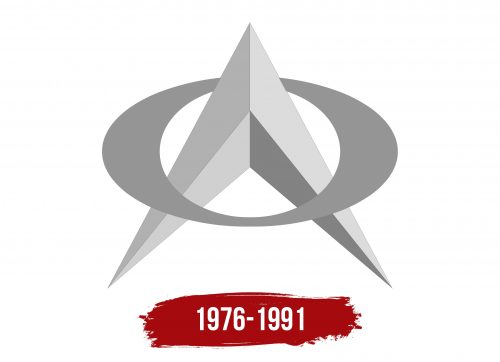The Oltcit logo reflects the company’s commitment to innovation and technological progress. Its dynamic shapes emphasize the vehicles’ high speed, while the restrained colors visually express reliability, professionalism, and engineering excellence.
Oltcit: Brand overview
The establishment of a new car manufacturing plant in Craiova by the Romanian government, led by Nicolae Ceaușescu, marked the beginning of Oltcit’s history in 1976. This choice was made as part of a larger plan to industrialize the nation and create a domestic auto sector.
The Romanian government sought a foreign partner with auto manufacturing expertise to carry out this enormous project. Following negotiations with other companies, an agreement with the French automaker Citroën was concluded in 1976. As a result of this agreement, a joint venture was established. “Olt” (the name of the river that flows through the Oltenia region, where Craiova is located) and “Cit” (short for Citroën) were combined to create the corporate name.
The factory was built in record time, with construction starting in 1977. The first automobiles came off the assembly line in 1981. The Citroën Visa prototype served as the basis for the first model, the Oltcit Special, which underwent several changes to suit the demands of the Romanian market and the factory’s manufacturing capacity.
Citroën created a small front-wheel-drive car called the Oltcit Special. It had an air-cooled, two-cylinder engine displacing 652 cc. This engine was selected because of its simplicity and dependability, which was important considering Romania’s poor service capabilities.
In 1982, the company started exporting automobiles to several Western European nations and other nations in the Eastern Bloc. The vehicle was marketed as the Citroën Axel in Western Europe to increase its buyer appeal.
Manufacturing encountered several issues despite its lofty goals. Frequent subpar construction brought about numerous customer concerns. Furthermore, shortages of components and resources resulted from Romania’s economic problems in the 1980s, which severely affected manufacturing.
The Oltcit Club, an upgraded vehicle version, was unveiled in 1988. This variant, also designed by Citroën, featured an enhanced design and a more potent 1129 cc engine. However, these upgrades did not greatly increase the car’s appeal.
The 1989 fall of the communist system in Romania and the ensuing economic reforms significantly impacted the operations. The business was confronted with a drop in customer demand and financial troubles.
Citroën sold the Romanian government its share in the joint venture in 1991. After that, the business changed its name to Automobile Craiova, while the Oltcit brand was still used.
Automobiles manufactured under the Oltcit name were formally stopped in 1994. The company produced about 160,000 cars in its lifetime, substantially decreasing from the initial projected production volumes.
After production, the Craiova plant was empty for a while. In 1994, the South Korean business Daewoo and the Romanian government inked an agreement for Daewoo to purchase a controlling interest in the factory. As a result, Rodae, subsequently known as Daewoo Automobile Romania, was established and started manufacturing Daewoo automobiles at the old facility.
Following Daewoo’s bankruptcy in 2007, Ford purchased the facility, and the automobile company is still based in Craiova.
Despite being relatively brief, Oltcit’s history plays a significant role in the history of the Romanian auto industry. It captures the aspirations and difficulties of the nation’s industrialization during the communist system and the hurdles of shifting to a market economy in the 1990s. Even though the Oltcit brand was discontinued, the Craiova plant—which Ford currently runs—remains a major player in Romania’s automotive sector.
Meaning and History
What is Oltcit?
The company was founded as a joint venture between the Romanian government and French automaker Citroën and was based in Romania. The company’s main markets were the domestic market and other Eastern European countries, for which it produced compact and inexpensive passenger cars. The models offered have been tailored to Romanian customers’ unique requirements and tastes, taking inspiration from Citroën design and using French technology and details. The company’s growth and competitiveness in the global market were ultimately hampered by problems such as resource shortages, outdated production facilities, and the centrally planned economy that many automakers in the region faced during the communist era, despite a partnership with the French automaker.
1976 – 1991
Oltcit has historical ties to Citroën, reflected in its similar logo. Designers intentionally achieved this resemblance to inspire trust in the new brand, leveraging the reliable reputation of the renowned French automotive company.
Like Citroën, the Oltcit emblem features a stylized chevron, though it is single rather than double. This element resembles an inverted “V” and suggests an upward-pointing arrow. Its clear geometric shape signifies the vehicle’s technological perfection.
The figure is formed by four gray triangles in varying shades, combining colors to create a sense of volume. Some may see this design as reminiscent of triangular compass arrows—a symbol of navigation, confidence, a well-chosen path, and forward movement. In this context, the inverted “V” indicates the company’s determination and drive for innovation.
The chevron is placed within a horizontal oval, representing the first letter of Oltcit. The circle adds symmetry and completeness to the logo. It also evokes a road, symbolizing the brand’s connection to the automotive industry. This element is also gray. The restrained tones give the emblem a modern and technological appearance, as the gray palette is associated with metal.





